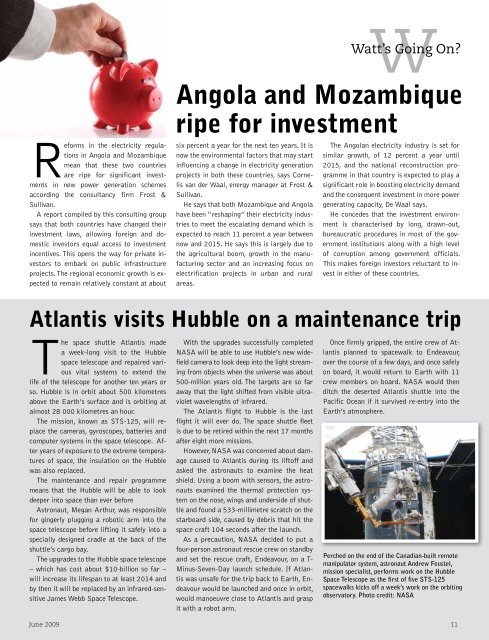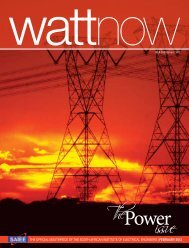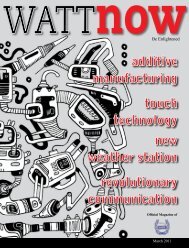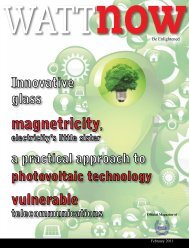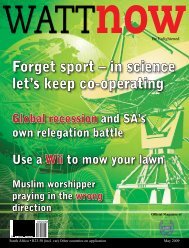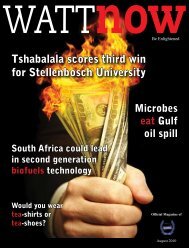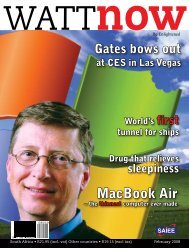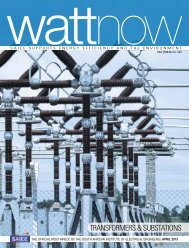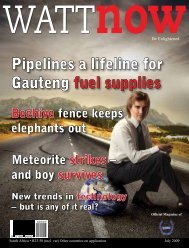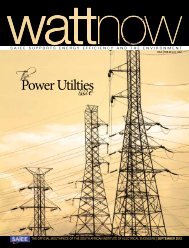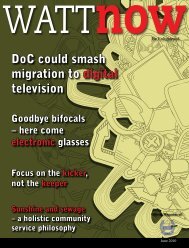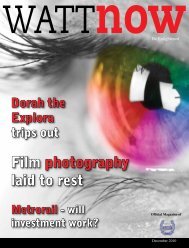download a PDF of the full June 2009 issue - Watt Now Magazine
download a PDF of the full June 2009 issue - Watt Now Magazine
download a PDF of the full June 2009 issue - Watt Now Magazine
- No tags were found...
Create successful ePaper yourself
Turn your PDF publications into a flip-book with our unique Google optimized e-Paper software.
Reforms in <strong>the</strong> electricity regulationsin Angola and Mozambiquemean that <strong>the</strong>se two countriesare ripe for significant investmentsin new power generation schemesaccording <strong>the</strong> consultancy firm Frost &Sullivan.A report compiled by this consulting groupsays that both countries have changed <strong>the</strong>irinvestment laws, allowing foreign and domesticinvestors equal access to investmentincentives. This opens <strong>the</strong> way for private investorsto embark on public infrastructureprojects. The regional economic growth is expectedto remain relatively constant at aboutW<strong>Watt</strong>’s Going On?Angola and Mozambiqueripe for investmentsix percent a year for <strong>the</strong> next ten years. It isnow <strong>the</strong> environmental factors that may startinfluencing a change in electricity generationprojects in both <strong>the</strong>se countries, says Cornelisvan der Waal, energy manager at Frost &Sullivan.He says that both Mozambique and Angolahave been “reshaping” <strong>the</strong>ir electricity industriesto meet <strong>the</strong> escalating demand which isexpected to reach 11 percent a year betweennow and 2015. He says this is largely due to<strong>the</strong> agricultural boom, growth in <strong>the</strong> manufacturingsector and an increasing focus onelectrification projects in urban and ruralareas.The Angolan electricity industry is set forsimilar growth, <strong>of</strong> 12 percent a year until2015, and <strong>the</strong> national reconstruction programmein that country is expected to play asignificant role in boosting electricity demandand <strong>the</strong> consequent investment in more powergenerating capacity, De Waal says.He concedes that <strong>the</strong> investment environmentis characterised by long, drawn-out,bureaucratic procedures in most <strong>of</strong> <strong>the</strong> governmentinstitutions along with a high level<strong>of</strong> corruption among government <strong>of</strong>ficials.This makes foreign investors reluctant to investin ei<strong>the</strong>r <strong>of</strong> <strong>the</strong>se countries.Atlantis visits Hubble on a maintenance tripThe space shuttle Atlantis madea week-long visit to <strong>the</strong> Hubblespace telescope and repaired variousvital systems to extend <strong>the</strong>life <strong>of</strong> <strong>the</strong> telescope for ano<strong>the</strong>r ten years orso. Hubble is in orbit about 500 kilometresabove <strong>the</strong> Earth’s surface and is orbiting atalmost 28 000 kilometres an hour.The mission, known as STS-125, will replace<strong>the</strong> cameras, gyroscopes, batteries andcomputer systems in <strong>the</strong> space telescope. Afteryears <strong>of</strong> exposure to <strong>the</strong> extreme temperatures<strong>of</strong> space, <strong>the</strong> insulation on <strong>the</strong> Hubblewas also replaced.The maintenance and repair programmemeans that <strong>the</strong> Hubble will be able to lookdeeper into space than ever beforeAstronaut, Megan Arthur, was responsiblefor gingerly plugging a robotic arm into <strong>the</strong>space telescope before lifting it safely into aspecially designed cradle at <strong>the</strong> back <strong>of</strong> <strong>the</strong>shuttle’s cargo bay.The upgrades to <strong>the</strong> Hubble space telescope– which has cost about $10-billion so far –will increase its lifespan to at least 2014 andby <strong>the</strong>n it will be replaced by an infrared-sensitiveJames Webb Space Telescope.With <strong>the</strong> upgrades success<strong>full</strong>y completedNASA will be able to use Hubble’s new widefieldcamera to look deep into <strong>the</strong> light streamingfrom objects when <strong>the</strong> universe was about500-million years old. The targets are so faraway that <strong>the</strong> light shifted from visible ultravioletwavelengths <strong>of</strong> infrared.The Atlantis flight to Hubble is <strong>the</strong> lastflight it will ever do. The space shuttle fleetis due to be retired within <strong>the</strong> next 17 monthsafter eight more missions.However, NASA was concerned about damagecaused to Atlantis during its lift<strong>of</strong>f andasked <strong>the</strong> astronauts to examine <strong>the</strong> heatshield. Using a boom with sensors, <strong>the</strong> astronautsexamined <strong>the</strong> <strong>the</strong>rmal protection systemon <strong>the</strong> nose, wings and underside <strong>of</strong> shuttleand found a 533-millimetre scratch on <strong>the</strong>starboard side, caused by debris that hit <strong>the</strong>space craft 104 seconds after <strong>the</strong> launch.As a precaution, NASA decided to put afour-person astronaut rescue crew on standbyand set <strong>the</strong> rescue craft, Endeavour, on a T-Minus-Seven-Day launch schedule. If Atlantiswas unsafe for <strong>the</strong> trip back to Earth, Endeavourwould be launched and once in orbit,would manoeuvre close to Atlantis and graspit with a robot arm.Once firmly gripped, <strong>the</strong> entire crew <strong>of</strong> Atlantisplanned to spacewalk to Endeavour,over <strong>the</strong> course <strong>of</strong> a few days, and once safelyon board, it would return to Earth with 11crew members on board. NASA would <strong>the</strong>nditch <strong>the</strong> deserted Atlantis shuttle into <strong>the</strong>Pacific Ocean if it survived re-entry into <strong>the</strong>Earth’s atmosphere.Perched on <strong>the</strong> end <strong>of</strong> <strong>the</strong> Canadian-built remotemanipulator system, astronaut Andrew Feustel,mission specialist, performs work on <strong>the</strong> HubbleSpace Telescope as <strong>the</strong> first <strong>of</strong> five STS-125spacewalks kicks <strong>of</strong>f a week’s work on <strong>the</strong> orbitingobservatory. Photo credit: NASA<strong>June</strong> <strong>2009</strong> 11


